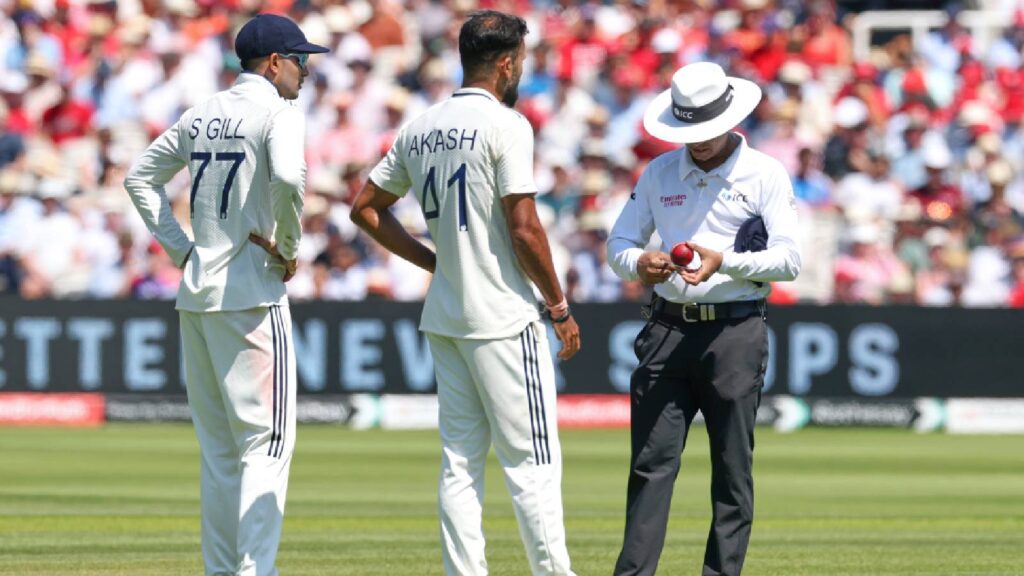India’s team management is not happy with the ball-change protocol during the ongoing Test series in England and has conveyed its concerns to the ICC match referee. The management also believes that England got preferential treatment when it came to choosing balls at the start of the crucial third Test of the series at Lord’s earlier this month.
The Indian Express has learnt that during England’s first innings at Lord’s, when the second new ball went out of shape after 10 overs, the replacement turned out to be 30-35 overs old. The protocol states the replacement needs to be as old as the original but it is learnt that the umpires told the team there was no ball in stock that was 10 overs old.
The Indians feel that since they got a softer and older replacement for a harder ball, which had been swinging and getting seam movement in the first 10 overs, it put them at a disadvantage in the Test that England eventually won by 22 runs to take a 2-1 lead in the series. The fourth Test ended in a tense draw with the last match starting on Thursday.
“At Lord’s, after about 10 overs, the Dukes ball lost its shape, something that has been happening so often in the series. The ball failed to pass through the rings that the umpires carry on the field to check if the ball is uniformly spherical. However, the umpires didn’t have a ball that was 10 overs old, so the Indian team at a crucial moment of the match got a ball that was 30-35 overs old,” said an Indian team official.
“Check the scoreboard to see how the game changed after that. The bowlers lost their swing and England scored with ease,” the official said.
On getting the much older ball, the Indian team management appealed to the match referee to allow them to switch back to the original that had gone out of shape. That’s when they were shown the rule book.
“When you ask for a ball change, you aren’t told about the age of the replacement you will be getting. At Lord’s, we weren’t told that the replacement would be 30 to 35 overs old. If we were told, we would have continued with the deformed ball that was used for 10 overs. The ICC needs to intervene. This rule needs to be changed,” he said.
Story continues below this ad
At Lord’s, before the ball went out of shape, India’s pace spearhead Jasprit Bumrah was getting it to talk, pocketing three wickets in 14 balls.
Bumrah first got England captain Ben Stokes bowled with one that snaked in between bat and pad. After that, Joe Root couldn’t read a fast incoming ball that took his bat’s edge and shattered the stumps. Following Root, all-rounder Chris Woakes edged his first ball, a swinging delivery that straightened after pitching, to the wicketkeeper. It was at this moment that the ball got changed as also the flow of the Test.
“The second new ball… swung 1.869 degrees and seamed 0.579 degrees on average. The replacement ball swung 0.855 degrees on average and seamed 0.594 degrees,” espncricinfo.com reported.
Turning point
From wickets falling in clumps, the Indians started to struggle with the benign replacement. The next two batsmen – wicket-keeper Jamie Smith and all-rounder Brydon Carse – enjoyed an easy ride as the replacement ball didn’t swing. This helped them compile a late-order game-changing partnership. Smith scored a 56-ball 51 and Carse an 83-ball 56, as the two took the score from 271 for seven to 355 for eight. In a match that India lost by 22 runs, this was a significant partnership.
Story continues below this ad
At the end of Day 2, Bumrah’s displeasure was evident but he didn’t speak on the issue.
“The ball changes, I don’t really control that. Obviously, I don’t want to lose out on money because I work very hard and play a lot of overs. So, I don’t want to say any controversial statements and get my match fees deducted,” he said.
According to the Indian team official, there is an urgent need to take a fresh look at the process to pick balls for every Test. According to convention, the fourth umpire, who is from the host country, comes to the dressing room with a box of balls and asks the team to pick two that they will bowl with during the Test. “The match referee, the neutral chief judge of the Test, is not present,” said the official.
During the ongoing series, there have been instances of the fourth umpire coming to the Indian dressing room with a box that had just one ball that had a darker shade of red and the rest pure red. It is said that the balls with darker shade swing more.
Story continues below this ad
“I am not alleging anything but when we asked for the darker ball, we were told that was the ball England had selected as their second new ball,” said the official.
He went on to say that the system can easily be manipulated by the home team since there is no involvement of match referees. “The right thing would be to have this ball selection in the match referee’s room and not in the dressing room with the local umpire as the only official present,” he said.


